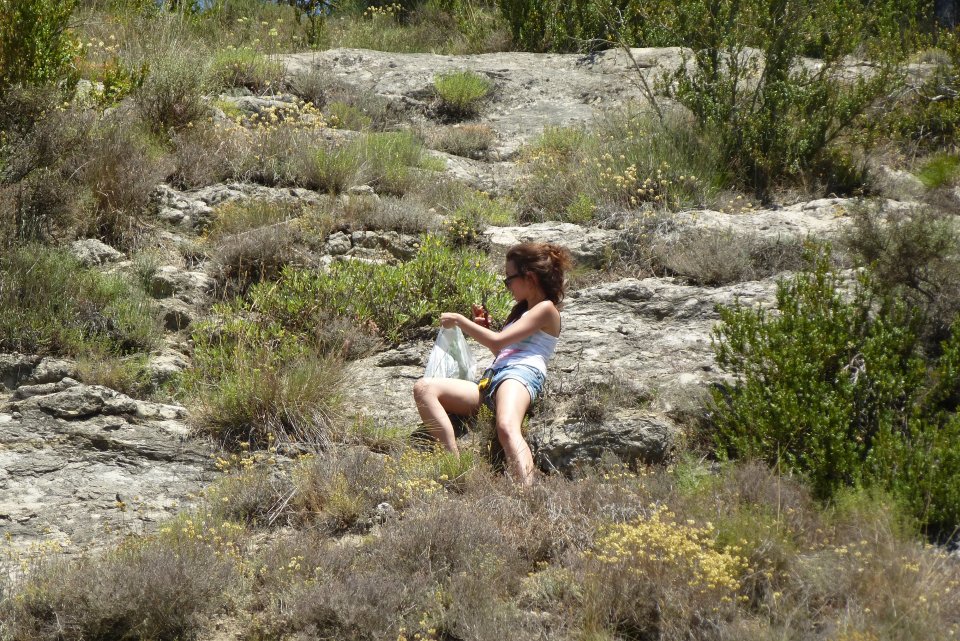
With the aim of knowing the quality and geographical distribution of some aromatic and medicinal species used at industrial level of the Spanish autochthonous flora, for some years projects were carried out for prospecting wild populations of Rosmarinus officinalis, Thymus vulgaris, Salvia lavandulifolia and Lavandula latifolia among others.
The purpose of these projects was to find quality plant material of these species with which to start breeding work in order to obtain commercial varieties adapted to our soil and climate conditions and make them available to the agricultural sector.
The large-scale production of medicinal and aromatic plants (MAP) oriented to sell the product (either dry plant or essential oil) in bulk to industry, requires knowledge of the plant material with which it is working. One of the disadvantages of wild collection of MAP on a large scale is the variability of the plant material obtained, therefore, the cultivation of those species with more demand is a necessity. In order to implement large-scale cultivation, commercial varieties that guarantee certain yields and qualities must be available. The attainment of these varieties is the result of improvement work from wild populations prospected.
For all species, although with particularities, the results showed: 1.- a great variability among wild populations, grouping them by clusters according to their chemical profiles and their main components, 2.- correlation between some aspects of yield and quality with edafoclimatic, geographic, phenological and age factors of the plant, and 3.- chemical profiles of some populations that did not fit with the standards established by the international quality standards for essential oils (Standards by ISO/TC 54).
For all these reasons and as a conclusion, it is necessary to have this knowledge in order to discriminate between populations, initiate breeding work and establish the best agronomic conditions to obtain quality productions with good yields.
Currently, the majority supply of MAP plant material found by farmers are ornamental varieties and only for a few species are commercial varieties of MAP available oriented to the industrial production of active ingredients. Producers who want to grow MAP for industrial purposes have to overcome this obstacle and ensure that the chosen variety has a commercial outflow. In addition, they must also validate the response of those commercial varieties subject to specific soil, climatic and cultural conditions before starting large areas of cultivation.
The local ecotypes can be cultivated in those models of production of artisan MAP oriented to the elaboration of final products either for food, cosmetics or hygiene.
The cultivation of selected commercial varieties of MAP will have a positive impact on the agricultural sector as it will guarantee farmers yields and qualities that are impossible to guarantee with the cultivation of local ecotypes. At the same time, it will also offer guarantees of supply, homogeneity and quality to the user industry, which will contribute, in the long term, to the establishment of links between the two sectors.
Faced with this situation, the main handicap is the difficulty of starting this work to improve the wild flora as they require large investments in time and in resources.
The study of wild flora and its natural distribution is the basis for identifying the most interesting populations with commercial output. The morphological and chemical characteristics of the plant material and the existing variability between populations must be known, either for harvesting or for starting crops.
The choice, together with the industry, of some species of our own flora and the attainment of commercial varieties improved agronomically and chemically is fundamental for the development of an organized and competitive productive sector capable to offer a dry plant or essential oils in quantity and quality.
These works are also fundamental to value the autochthonous flora of each territory.
Roser Cristóbal Cabau, roser.cristobal@ctfc.es, www.ctfc.cat
Further information
David Herraiz-Peñalver, Jaime Usano-Alemany, Joaquin Cuadrado, Maria José Jordán, Vanessa Lax, José Antonio Sotomayor, Jesús Palá-Paúl. 2010. Essential oil composicion of wild population of Salvia lavandulifolia Vahl. From Castilla-La Mancha (Spain). Biochemical Systematics and Ecology 38, pg: 1224-1230.
David Herraiz-Peñalver, María Ángeles Cases, Federico Varela, Paloma Navarrete, Raúl Sánchez-Vioque, Jaime Usano-Alemany. 2013. Chemical characterization of Lavandula latifolia Medik. Essential oil from Spanish wild populations. Biochemical Systematics and Ecology 46, pg: 59-68.
Jaime Usano-Alemany, Jesús Palá-Paúl, David Herráiz-Peñalver. 2016. Essential oil yields and qualities of different clonal lines of Salvia lavandulifolia monitored in Spain over four years of cultivation. Industrial Crops and Products 80, pg:251-261.
A. Cases, B. Pérez, P. Navarrete, E. Mora, B. Peña, A. Peluzzo, R. Calvo, D. Sánchez de Ron, F. Varela. 2009. Variability in the chemical composition of wild Thymus vulgaris L. Proc. Ist IC on Culinary Herbs. Acta Hort. 826, pg:159-165.
Varela R., Hernán G., Navarrete P., Pérez B., Pérez-Mao D., López-Cepero Pl, Cuadrado J., Herraiz D., Usano-Alemany J., Sotomayor J.A., Jordán M.J., Cristóbal R., Fanlo M., Melero R., Moré E., Cabot Pl, Asensio S.-Manzanera, M.C., Asensio Vegas C., Martín H., Herrero B., Fernández M., Peluzzo A., González Benito M.E., Pérez F., Sánchez D., Cases M.A. 2009. Bioprospecting: genetic resources of medicinal and aromatic plants in Spain.
F. Varela, P. Navarrete, R. Cristóbal, M. Fanlo, R. Melero, J.A. Sotomayor, M.J. Jordán, P. Cabot, D. Sánchez de Ron, R. Calvo A. Cases. 2009. Variability in the chemical composition of wild Rosmarinus officinalis L. Proc. Ist IC on Culinary Herbs. Acta Hort. 826, pg: 167-174.
Roser Cristóbal, CTFC

Chemical composition of wild Salvia lavandulifolia in the different Spanish prospected areas
